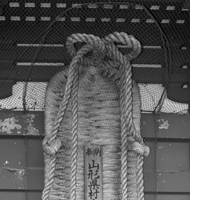Dear Alice,
Last month, I was one of the two million spectators in Asakusa for the Sanja Matsuri. It was thrilling to see the festival up close, but the crowd was so thick that sometimes I couldn't move. At one point I found myself pinned by the big red inner gate at Sensoji Temple, giving me plenty of time to ponder the gigantic straw sandals hanging on either side of it. Can you tell me why the heck oversize footwear adorns a temple gate?
Peter B., Kanagawa
Dear Peter,
I know just where you were pinned: Around the back of the Hozomon Gate that stands in front of the Kannon Hall at Sensoji. The sandals are called owaraji, waraji being traditional straw sandals and the o in front meaning they are big.
And are they ever! Each is 4.5 meters in length (longer than two tatami mats laid end to end), and 1.5 meters wide. They weigh in at about 500 kg apiece.
To track down why they are there, I started with the photo you sent, which shows a sign stating the sandals were presented by the honokai (dedicatory committee) of a city in Yamagata Prefecture.
I called up the Maruyama city office and was put through to an official in charge of culture and tourism. He explained that the town has provided sandals to Sensoji since 1941, when a Diet member named Toshizou Matsuoka who hailed from Murayama decided, by way of thanks for central government relief for snow damage in his district, to make an offering for the country's safety in the ongoing war. Matsuoka organized his hometown to weave a pair of giant sandals. Right about now you're probably thinking, "Why sandals?"
There's a long tradition of offering straw sandals to temples and shrines. Woven straw sandals were a common form of footwear from at least the 9th century until well into the 20th century, according to Kyoko Ichida of the Japan Footwear Museum in Hiroshima Prefecture.
Simple versions called warazori were for everyday wear, while waraji, which have ties to secure the woven sole to the foot and leg, were for travel and work. At some point, people began to offer waraji as part of theirprayers, primarily for safe travel and lower-body health. "Leg strength was very important in those days," Ichida explained. "If your legs weren't strong enough for labor, you didn't eat."
The first pair of owaraji presented to Sensoji was destroyed along with the temple during the 1945 incendiary bombing, but the people of Murayama donated replacements in 1964 and roughly every 10 years since.
The current pair was donated in 1998, which means the town will be gearing up soon to start another set. The entire process takes a year and a half and requires the labor of about 800 people, who do everything from growing the rice straw in a dedicated paddy to cooking meals for the sandal-making volunteers.
The Sensoji owaraji may be big, but the title for the biggest probably goes to Fukushima City, which puts on a Waraji Festival on the first Friday and Saturday in August every year.
The highlight is a race between two teams hauling two-ton sandals through the city. One ends up on display outside a local shrine; like a totem pole, standing upright it reaches 12 meters high.
For the record, owaraji are not solely religious; they have secular uses too. Now and again you'll see them hung outside a nomiya (drinking joint), where you're likely to find traditional decor and rural-style fare.



